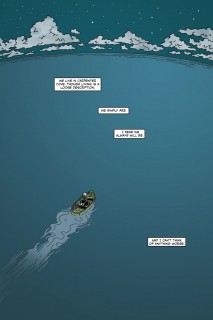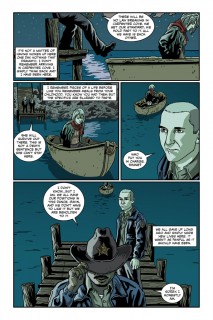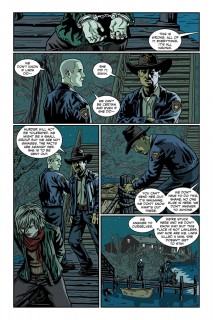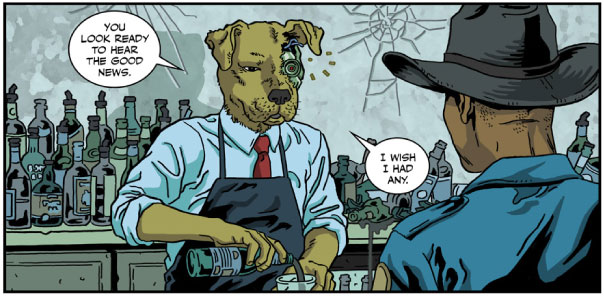“There are a handful of moments where I want to really grab readers by the collar and slap them.” Ryan K Lindsay gets inside the mind of a serial killer in Headspace
 Ever wanted to look inside the mind of a serial killer? Wait… come back… it’s not another gore filled murder book! In the case of Headspace from MonkeyBrain Comics, the world inside the head of a serial killer is a surreal piece of small town Americana, that’s more Truman Show than Dexter. With all the tropes you would expect (right down to the word weary sheriff and bartender), but with a generous dose of surreality inspired by TV shows like the Prisoner, it’s another genre-defying read from the crew at MonkeyBrain. Keen to find out more about this strange new world, we contacted creator and writer Ryan K Lindsay to find out just where his head was at when writing Headspace.
Ever wanted to look inside the mind of a serial killer? Wait… come back… it’s not another gore filled murder book! In the case of Headspace from MonkeyBrain Comics, the world inside the head of a serial killer is a surreal piece of small town Americana, that’s more Truman Show than Dexter. With all the tropes you would expect (right down to the word weary sheriff and bartender), but with a generous dose of surreality inspired by TV shows like the Prisoner, it’s another genre-defying read from the crew at MonkeyBrain. Keen to find out more about this strange new world, we contacted creator and writer Ryan K Lindsay to find out just where his head was at when writing Headspace.

The story is about a fictional small town inside the brain of a serial killer, is that right, where did the inspiration and idea for that come from?
RKL: Yep, we’ve got a landscape that’s completely fabricated and in the mind of a killer. I think deep down repeated childhood viewings of Inner Space must have helped and then decades of Philip K Dick warped this idea until Headspace spewed forth.
Initially, the idea was for the government to be establishing jails inside people due to overpopulation and real estate issues but the more I worked the story, and the more the characters developed, the more Headspace came into view. The idea of the government using these towns, and the people they put in there, as a mine for memories and information is just such a rich concept. It seemed too unique and fun to ignore.
It has a very Truman Show feel was that an inspiration for you? You also mention UK show The Prisoner how influential was that in shaping the look and feel?
RKL: This isn’t the first time I’ve heard The Truman Show mentioned and while it wasn’t an overt inspiration it is a movie I really dig – and directed by an Aussie and written by a Kiwi so I guess the link might be there. The whole idea of a fabricated reality is certainly something exciting to plumb. The fear that maybe all we know isn’t what we should and could know strikes many people all the time. The worry you’re being left out of something, that you aren’t privy to the real information, is something that would destroy you were you to figure it out too late. I like that idea of a character only knowing for certain what they feel and believe in and then having them steer true to that compass.
As for The Prisoner, it was something I watched while scripting much of this series and while they certainly share DNA threads I was happy to see I didn’t borrow anything from it consciously or not. But the idea of fighting against omnipotent authority is the sort of narrative base that always works from The People Vs Larry Flynt to Fight Club. We never know what’s happening around us but we trust it implicitly. I don’t think we should.

The book has a lot of fantastical and surreal moments was that part of The Prisoner being an influence?
RKL: Something I continue to consciously think about is the fact I want this book to run into gonzo territory from time to time. Carpenter Cove is a town in literal real estate of the mind. Anything can happen and should. It keeps it interesting and keeps you on your toes. There are a handful of moments in this first issue where I want to really grab readers by the collar and slap them.
I certainly loved how you never knew what kind of episode you’d get with The Prisoner. I want moments of this book to feel like a dark spin on the places the Coen Brothers would be confident to go. I only really want to do new things here.
It’s quite a slow burner in the first issue and you keep the main premise quite concealed, is that part of a long term plan for the story and how long is it planned to run for?
RKL: Most of what you need is in this first issue. By the end of the second issue, pretty much all the cards are on the table. We keep a few face cards for later but the playing field will be clear. Every episode adds to the landscape as well as builds our two leads, Shane and Max.
The story is planned to run throughout all of 2014. And we definitely have a clear end in mind and every panel is building towards it.

What is it about the idea of an isolated small town in America that makes for such a rich source of story telling?
RKL: I think because they were always held as these stellar examples of perfection but we now are happy to understand that still waters run deep. And dark. Twisting that pristine image, warping that golden morality is always going to be fun.
The book has split art styles for the two parts of the story, how did you hook up with the various artists involved?
RKL: Eric Zawadzki does the pages in Carpenter Cove. He and I first began breaking this story back at the end of 2012. We knew each other through twitter circles, I guess. He’s been a dreamboat to collaborate with as he has a great brain for story, he colours his own pages, and he letters the whole thing.
Then there’s Chris Peterson, who I also know through twitter, and he’s drawing the sequence of Max, the man housing Carpenter Cove, in real life. His loose style makes these action scenes really pop and I think we’re all blessed to have Marissa Louise coloring this sequence. She’s going to be huge and I’m honored to have her with us for just a few pages an issue.
How did you get hooked up with MonkeyBrain Comics and what do they bring to the table for you? Are you a big fan of digital comics yourself?
RKL: MonkeyBrain are one of my favourite publishers active right now. I’ve been following them, and near on their whole crop of books, closely from their very first day. It was a dream to land at MonkeyBrain and one only realised because Christopher Sebela (the writer of High Crimes, which you should all check out) was nice enough to introduce me to Chris Roberson in Seattle at ECCC. From there, we got chatting and eventually I showed the pitch and Mr Roberson was classy enough to greenlight our little dream.
I think MonkeyBrain are really firing on all cylinders because Chris and his wife Allison are smart enough to get out of the way of the people they believe in. They bring in teams on books they would want to see and then they allow the creative process to flourish. There are so many great books at Monkeybrain and that’s no accident. I also really dig digital comics, I have my iPad with me at all times, so I’ve got a library of story to access at any time. Then there’s the 99c price point, which Monkeybrain don’t enforce but you can see why people like it. Popping another 99c into the machine to read the next installment just feels right and easy to do. I know I love me some 99c weekly digital comics and the sales destroy me every week.
I think, by now, people feel safe testing the MonkeyBrain waters because the price is always right and the label of the imprint denotes quality every time. Like Vertigo, and now Image, when people see a MonkeyBrain book they expect, and most usually receive, exactly what they want and deserve.

Finally, any surprises or characters we should keep an eye out for in future issues that you are particularly excited about?
RKL: I’m really enjoying playing with the iterations of Max in Carpenter Cove. It’s inside his mind so we see different aspects of his personality in isolation, ways he sees himself, things he hides, and that’s an interesting way to dissect a character.
I also want to shout out to Gil, the dog-headed bartender in this first issue who I love with all my brain and heart.
But the last thing I’ll say is, pretty much everything means something so pay attention during this first issue because much of it gets paid off down the track, I promise.
Headspace #1 is available from MonkeyBrain Comics via ComiXology on March 4th. For more on Ryan visit his website or follow him on Twitter.



New MonkeyBrain comics: Anti-Hero #8, The Remains #2 and Headspace #2
April 8, 2014 @ 8:19 pm
[…] Download Headspace #2 from ComiXology here Read our exclusive interview with Headspace writer Ryan K Lindsay here […]